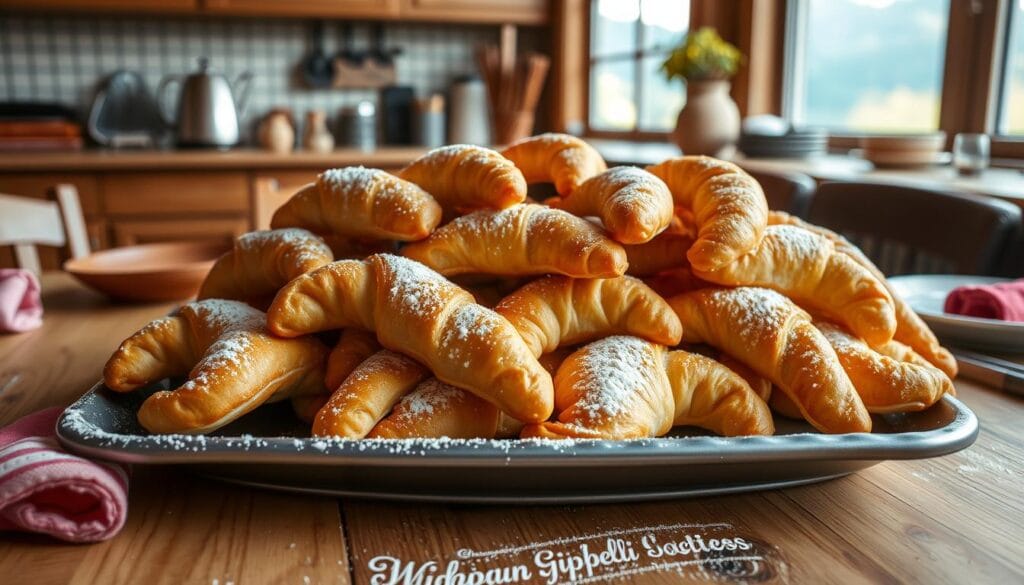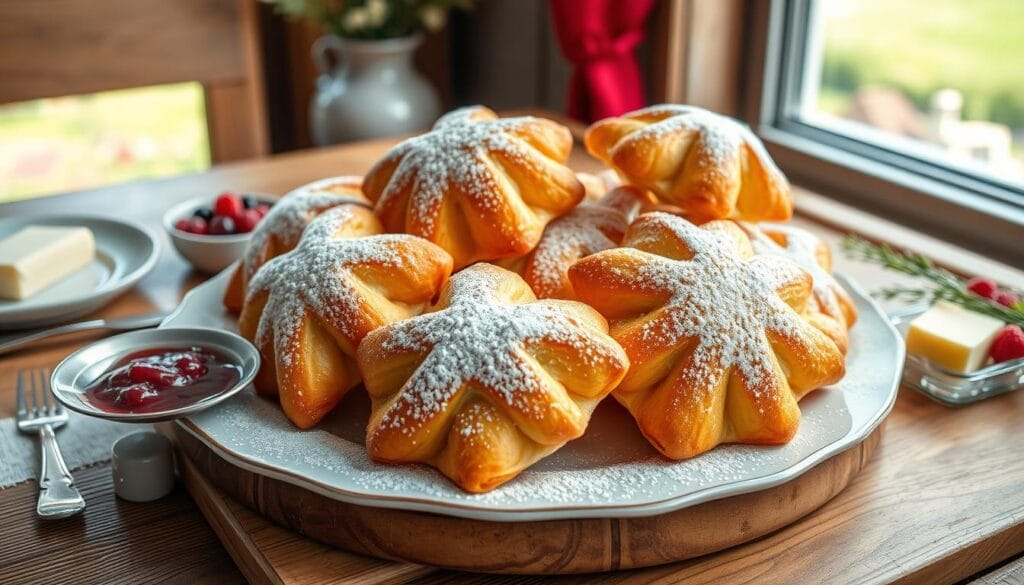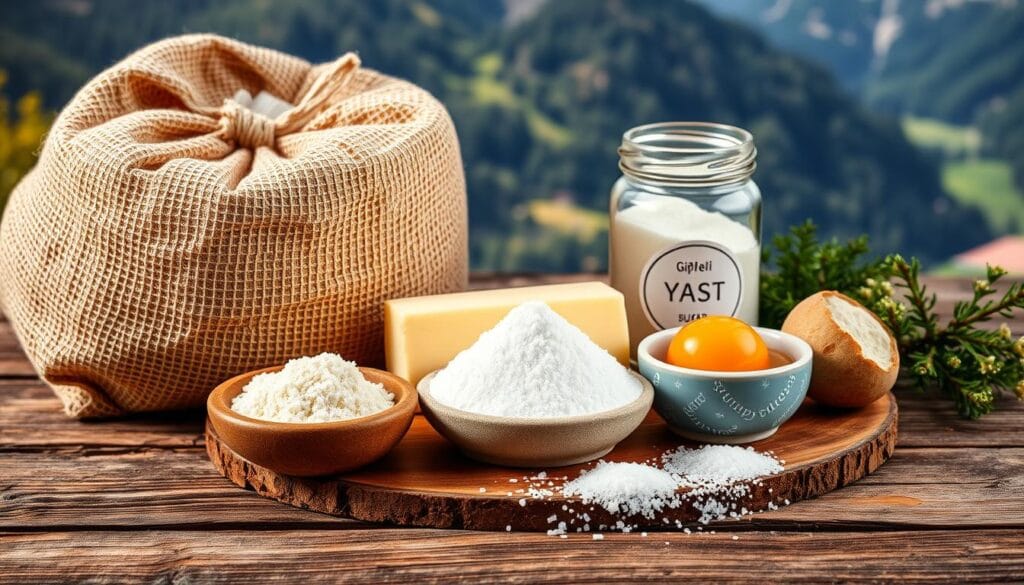Table of Contents
Learn how to bake authentic Swiss gipfeli with this simple recipe. Making the flaky layers and buttery goodness of this pastry takes practice. But with the right steps, you can get professional results. Gipfeli is a key part of Swiss baking, rich in history and culture. Check out more at Recipe Joys.

This recipe will teach you about gipfeli’s origins and how it’s traditionally served. You’ll also learn about the key ingredients for this tasty Swiss pastry. With this recipe, you’ll make a treat that will wow your loved ones.
Key Takeaways
- Master the classic Swiss gipfeli recipe with ease
- Learn the secrets to creating flaky layers in your Swiss pastry
- Discover the rich history and cultural significance of gipfeli
- Get the essential ingredients required to make authentic gipfeli
- Improve your baking skills with this easy-to-follow gipfeli recipe
- Create a delicious Swiss treat with a perfect balance of flavors and textures
The Swiss Heritage of Gipfeli Pastries
Gipfeli pastries have a long gipfeli history that goes back to the 17th century in Switzerland. The country’s Swiss heritage is deeply rooted in baking traditions. Gipfeli is a key part of this heritage. Learning about the cultural significance of gipfeli helps us appreciate Swiss baking and the need to keep traditional recipes alive.
Exploring gipfeli reveals its unique ingredients and baking methods. These set it apart from other pastries, like French croissants. The Swiss heritage of gipfeli is seen in its traditional serving customs, still followed today. Enjoying gipfeli, whether at a local bakery or at home, connects us to Swiss heritage.
Origins and Cultural Significance
The roots of gipfeli are deeply connected to Switzerland’s cultural significance. It’s a favorite at social events and special occasions, like weddings and holidays. Paired with coffee or tea, its flaky layers and sweet taste are loved by the Swiss.

How Gipfeli Differs from French Croissants
Though gipfeli and French croissants share similarities, they differ in ingredients and baking techniques. Gipfeli uses a special flour and a unique lamination process. This gives it a distinct texture and flavor. The gipfeli history showcases Swiss bakers’ creativity and skill in making this tasty pastry.
| Gipfeli | French Croissants |
|---|---|
| Special type of flour | Butter and yeast dough |
| Unique lamination process | Layered dough with butter |
| Sweet flavor | Flaky and buttery flavor |
Essential Ingredients for Authentic Gipfeli
To make authentic gipfeli, you need top-notch gipfeli ingredients. This includes Swiss flour, yeast, salt, sugar, and butter. The flour type is key for the pastry’s texture and taste. You can pick from all-purpose or bread flour for the best mix.
For Swiss pastry ingredients, the yeast quality matters a lot. Active dry or instant yeast is needed for the dough to rise. Also, use granulated or brown sugar for sweetness. The right mix of baking essentials will make your gipfeli delicious and true to its Swiss roots.
Here are some key ingredients you will need:
- Swiss flour
- Yeast
- Salt
- Sugar
- Butter

Using these quality ingredients will help you make a tasty and authentic gipfeli. Make sure to pick the right flour and yeast for the perfect texture and taste. With the right gipfeli ingredients and baking essentials, you’re on your way to a mouthwatering Swiss pastry.
| Ingredient | Quantity |
|---|---|
| Swiss flour | 2 cups |
| Yeast | 1 teaspoon |
| Salt | 1/2 teaspoon |
| Sugar | 1 tablespoon |
| Butter | 1/2 cup |
Required Kitchen Tools and Equipment
To start making gipfeli, you’ll need some key kitchen equipment and baking tools. You’ll need a stand mixer, pastry brush, rolling pin, and baking sheet. These tools are crucial for getting the right layers and texture in your gipfeli.
In pastry making, the quality of your tools really matters. A good rolling pin helps roll out the dough evenly and prevents sticking. A pastry brush is also key for applying egg wash or melted butter.
Optional tools like a pastry blender or dough scraper can also help you get professional results. By getting the right kitchen equipment and baking tools, you’ll be on your way to making tasty gipfeli at home.
Understanding the Perfect Dough Consistency
To make perfect gipfeli, knowing about dough consistency is key. The flour type, liquid amount, and temperature all play a role. Mastering these can help you make a dough that’s easy to work with and has flaky, buttery layers.
Getting the dough right is crucial in baking. The flour you choose can make your dough tender or not. Also, the liquid amount is important. Too much or too little can make the dough too sticky or dry.
- Type of flour: Different types of flour can affect the texture and consistency of your dough.
- Amount of liquid: The right amount of liquid is crucial for achieving the perfect dough consistency.
- Temperature: Temperature can affect the rise and texture of your gipfeli.
By considering these factors and following some simple baking tips, you can create a delicious and authentic gipfeli. Remember, practice makes perfect. So, don’t get discouraged if it takes a few tries to get the dough just right.
Complete Gipfeli Recipe and Instructions
To make gipfeli, you need to know about pastry making and follow baking steps carefully. Making gipfeli is a detailed process that takes patience. Remember, the more you practice, the better you’ll get at making flaky, buttery pastries.
First, mix flour, yeast, salt, and sugar in a big bowl. It’s important to mix well and let the dough rest. This lets the yeast work, making the dough light and airy.
Preparing the Base Dough
The lamination step is key in making gipfeli. It involves folding and rolling the dough to create layers. This needs patience and precision. With each fold and roll, the dough gets flakier, making the pastry delicious.
Shaping Techniques
After laminating, shape the dough into triangles and roll them into croissants. Shaping needs a gentle touch to avoid tearing. With practice, you’ll get better at shaping, making the pastries look and taste great.
Baking Guidelines
The last step is baking the pastries in a hot oven. Baking correctly is crucial for the right color and flakiness. Follow these guidelines to make gipfeli that will impress everyone.
Mastering the Lamination Process
To get the perfect layers in your gipfeli, you need to understand the lamination process. This is a key step in making pastry. You fold and roll the dough to create flaky layers, which are what make gipfeli special. You can use old-school folding or modern laminators to do this.
When baking, keeping the dough cold is crucial. This keeps the butter solid, which is key for flaky layers. Also, make sure to roll the dough to the right thickness. This affects the final texture of your gipfeli. By following these tips, you’ll make delicious, flaky, and buttery gipfeli.
Some important things to remember when mastering lamination include:
- Using the right type of flour, as this will affect the texture of the dough
- Keeping the dough cold, as this will help the butter to stay solid
- Rolling the dough out to the correct thickness, as this will affect the texture of the final product
By following these tips and practicing lamination, you’ll make gipfeli that will wow everyone. Always use top-notch ingredients and follow good baking tips for the best results.
Critical Tips for Flaky Layers
To get the perfect flaky layers in your gipfeli, you need to follow some key baking tips. Temperature control is crucial in pastry making. The right temperature ensures your layers are both flaky and tender.
Resting times are also vital. Letting your dough rest relaxes the gluten. This makes it easier to roll out and create the layers you want. The quality of butter used is another important factor. High-quality butter with a high fat content is key for the perfect flavor and texture.
Here are some more tips to remember:
- Keep your ingredients cold for the best flaky layers.
- Avoid overworking the dough to prevent a dense texture.
- Choose the right flour for the right texture and structure.
By following these baking tips and using the right techniques, you can make delicious gipfeli. Remember, it takes practice to get it right. Don’t get discouraged if it takes a few tries.
| Tips for Flaky Layers | Importance |
|---|---|
| Temperature Control | High |
| Resting Times | Medium |
| Butter Quality | High |
Common Mistakes to Avoid
When making gipfeli, attention to detail is key. You must avoid common mistakes that can ruin the texture and taste. Overmixing the dough is a big no-no, as it makes the pastry dense and tough. Mix your ingredients just until they form a shaggy mass, then let the dough rest.
Temperature control is also crucial. If your ingredients are too warm or cold, it messes with the lamination process. Make sure your butter is at the right temperature and your dough is room temperature before laminating. These tips will help you make flaky, delicious pastries that everyone will love.
Here are some common mistakes to watch out for in pastry making:
- Using the wrong type of flour, which can affect the texture and structure of your gipfeli
- Not controlling the temperature, which can impact the lamination process and the quality of your pastry
- Overworking the dough, which can lead to a dense and tough gipfeli
Knowing these common mistakes helps you avoid them. Follow these tips and take your time. You’ll end up with flaky, buttery gipfeli that are a true Swiss delight.
| Mistake | Effect on Gipfeli |
|---|---|
| Overmixing the dough | Dense and tough pastry |
| Incorrect temperature | Affects lamination process and pastry quality |
| Using wrong type of flour | Affects texture and structure of gipfeli |
Storage and Reheating Methods
To keep your gipfeli fresh and tasty, use the right storage and reheating tips. You can store them at room temperature, in the fridge, or freezer. The choice depends on when you want to eat them.
For a short time, keep gipfeli in an airtight container at room temperature. This keeps their texture and taste good. But, if you won’t eat them in a day or two, fridge or freezer is better. Always wrap them tightly in plastic or foil to avoid drying out.
Proper Storage Techniques
- Room temperature: Store in an airtight container for up to 2 days
- Refrigeration: Wrap tightly in plastic wrap or aluminum foil and store for up to 5 days
- Freezing: Wrap tightly in plastic wrap or aluminum foil and store for up to 2 months
Reheating Instructions
To reheat your gipfeli, use the oven or microwave. Preheat the oven to 350°F (180°C) and bake for 5-10 minutes. Or, wrap them in a damp paper towel and microwave for 20-30 seconds. These steps will help you enjoy your gipfeli perfectly.
Delicious Variations and Fillings
Mastering the classic gipfeli recipe opens up a world of gipfeli variations. You can play with pastry fillings to match your taste. Whether you prefer sweet or savory, there’s a wide range of baking ideas to try.
For sweet treats, fill your gipfeli with chocolate, fruit preserves, or nuts. For a richer taste, add caramel or dulce de leche. For savory options, try cheese, ham, or spinach. The secret is to find the right balance of flavors with the flaky pastry.
Sweet Options
- Chocolate fillings, such as dark, milk, or white chocolate
- Fruit preserves, like strawberry or raspberry
- Nutella or other nut-based fillings
Savory Alternatives
- Cheese fillings, such as cheddar, parmesan, or feta
- Ham or prosciutto fillings for a salty, meaty flavor
- Spinach or herb fillings for a fresh, savory taste
These gipfeli variations and pastry fillings can elevate your baking. They’re perfect for impressing friends and family. Whether you’re new to baking or experienced, trying new baking ideas is a fun way to stay creative.
Conclusion
Making Swiss gipfeli is a fun journey that needs patience and care. You’ve learned the key ingredients and techniques. Now, you can bake gipfeli that will amaze your family and friends.
Feel free to try the classic recipe or new flavors. Your gipfeli will become a favorite in your kitchen. Enjoy the process, accept the small mistakes, and love making pastry. With every bite, you’ll feel like you’re in a Swiss cafe.
Get your oven ready and start baking. Let the smell of gipfeli fill your kitchen. Bon appétit, and happy baking!
FAQ
What is the difference between gipfeli and French croissants?
Gipfeli and French croissants are both flaky, buttery pastries. But, they have some key differences. Gipfeli come from Switzerland and use special ingredients and baking methods. This makes them taste and feel a bit different from French croissants.
What type of flour is best for making authentic gipfeli?
Choosing the right flour is important for gipfeli. Swiss flour, which has less gluten than regular flour, is the traditional choice. It helps make the pastry flaky and tender.
What essential kitchen tools are needed to make gipfeli?
You’ll need basic baking tools to make gipfeli. These include a stand mixer, rolling pin, pastry brush, and baking sheets. Optional tools like a dough scraper and pastry mat can also help you get better results.
How do I achieve the perfect dough consistency for gipfeli?
Getting the dough right is key for flaky gipfeli. The type of flour, liquid, and temperature all matter. Knowing how to handle the dough will help your gipfeli turn out great.
What is the lamination process, and why is it important for gipfeli?
Lamination is a key step in making gipfeli. It involves folding and rolling the dough with butter to create flaky layers. Mastering this technique is crucial for the right texture and flavor.
What are some common mistakes to avoid when making gipfeli?
Avoiding common mistakes is important. Don’t overmix the dough, use the wrong flour, or let the temperature get out of control. Knowing these pitfalls can help you fix any issues.
How should I store and reheat gipfeli?
Storing and reheating gipfeli right is key. You can keep them at room temperature, in the fridge, or freezer. To reheat, use the oven or microwave to get them crispy again.
What are some delicious variations and fillings I can try with gipfeli?
You can try many fillings with gipfeli. Options include chocolate, fruit, cheese, and ham. Trying different fillings can make your gipfeli baking even more fun.